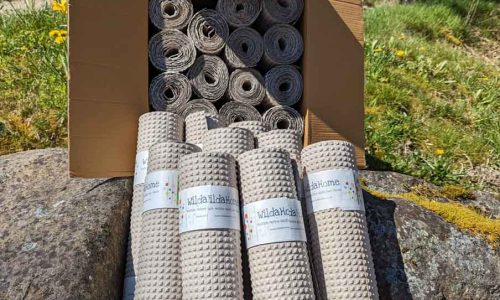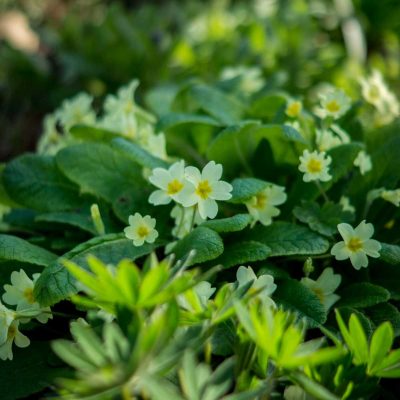Thriving in the Shadows: The Ultimate Guide to Wildflowers and Seed Mats for Woodland and Heavy Shade in the UK
A hidden world of flora thrives in the dappled light of the UK’s woodlands and shaded gardens. These are the environments where sunlight is a fleeting visitor, yet a diverse range of wildflowers flourish, painting the ground with vibrant colours and textures. This guide delves into the realm of shade-tolerant wildflowers, exploring how they can transform shaded areas into thriving ecosystems.
Introduction to Shade-Tolerant Wildflowers
Shade-tolerant wildflowers are specially adapted to grow in low-light conditions in woodlands and shaded gardens. These resilient species provide essential habitat and food for pollinators and wildlife, contributing significantly to biodiversity. From the Wood Anemone’s delicate blooms to the Foxglove’s understated beauty, these plants offer a spectrum of colours, shapes, and sizes that can beautify even the most shadowed corners of a garden.
Understanding the Challenges of Woodland Gardening
Gardening under the canopy of trees or in heavily shaded areas presents unique challenges. These include limited light, competition from tree roots, and potentially dry or nutrient-poor soil. Success in these conditions requires selecting the right plants naturally adapted to thrive under such constraints.
The Magic of Wildflower Seed Mats for Shaded Areas
Wildflower seed mats are a novel solution for effortlessly introducing native wildflowers into shaded gardens. These mulch mats contain a mix of shade-tolerant wildflower seeds, They simplify planting, ensure optimal seed distribution, and reduce the need for meticulous maintenance, making them ideal for busy gardeners looking to enhance their shaded spaces.

Key Species in Wildahomes' Shade-Tolerant Seed Mix
Wildahomes’ woodland and heavy shade seed mix is carefully curated to include species that survive and thrive in shaded conditions. Some standout species include:
Wood Anemone (Anemone nemorosa): A spring bloomer with delicate white flowers, ideal for dappled shade under trees.
Foxglove (Digitalis purpurea): Tall spikes of pink or white tubular flowers that attract bees and other pollinators.

Primrose (Primula vulgaris): Early spring flowers in shades of yellow, creating a soft carpet underfoot.
Red Campion (Silene dioica): Offering vibrant pink blooms, this plant adds colour to the shade garden.
These species are selected for their compatibility with UK climates and their ability to coexist, creating a balanced and self-sustaining ecosystem.
Planting and Care Guide for Shade-Loving Wildflowers
Planting wildflower seed mats is straightforward: lay the mat on prepared soil and cover it lightly with soil or compost and water. The key to success lies in keeping the area moist until germination and ensuring the soil is well-draining to prevent waterlogging. Once established, shade-tolerant wildflowers require minimal maintenance, mostly self-seeding and spreading to cover the desired area.
Designing a Woodland Wildflower Garden: Tips and Tricks
Creating a visually appealing woodland garden involves more than just planting seeds. Consider the following tips:
Layering: Utilize plants of varying heights to create depth, from low-growing Primroses to taller Foxgloves.
Colour Coordination: Plan your garden so that colours complement each other and bloom times overlap, ensuring continuous colour.
Natural Look: Arrange plants in a seemingly random pattern to mimic the natural randomness of a woodland floor.
The Ecological Benefits of Woodland Wildflowers
Woodland wildflowers play a crucial role in the ecosystem, supporting a range of wildlife. They provide nectar for pollinators and a habitat for insects and contribute to the soil’s health by adding organic matter and improving its structure.
Case Studies: Successful Woodland and Shade Wildflower Projects
Across the UK, numerous gardens and woodlands have been transformed by introducing native wildflowers. One notable example is a community project in Devon, where a previously barren shaded area was revitalised with Wildahomes’ seed mats, resulting in a vibrant ecosystem buzzing with life.
Questions about Sowing and Growing Wildflowers in Shaded Areas and Woodland
- What are the best conditions for sowing wildflower seeds in shaded areas?
Answer: The best conditions for sowing wildflower seeds in shaded areas include moist, well-drained soil and minimal competition from grasses and invasive species. Sowing during early spring or autumn is essential to take advantage of cooler temperatures and natural rainfall. - Can I sow wildflower seeds directly onto the soil, or must I prepare the ground first?
Answer: It’s essential to prepare the ground first by clearing away any debris, weeds, or grass that could compete with the wildflower seeds. Lightly raking the soil to create a fine tilth can improve seed contact with the soil, enhancing germination rates. - How do I choose the suitable wildflower species for shaded woodlands?
Answer: Select species naturally adapted to shaded conditions, such as Wood Anemone, Bluebell, and Foxglove. Research or consult with a specialist to find a mix designed explicitly for shaded or woodland areas to ensure the best results. - How often should I water newly sown wildflower seeds in a shaded area?
Answer: Newly sown wildflower seeds should be kept moist but not soggy. Watering gently once a day, especially during dry spells, until germination occurs is usually sufficient. After germination, you can reduce the watering frequency as the plants establish. - Do wildflowers in shaded areas require any special care or maintenance?Answer: Wildflowers in shaded areas generally require minimal maintenance. However, it’s beneficial to remove invasive species that may compete for resources and to cut back the growth at the end of the flowering season to help distribute seeds and encourage new growth the following year.
- When can I expect to see blooms after sowing wildflower seeds in a woodland area?
Answer: Many wildflower species germinate within two to three weeks, but flowering times can vary depending on the species and planting conditions. Some may bloom in the first year, while others, particularly perennials, may not bloom until the second year after sowing. Patience is key; establishing a booming wildflower area in shaded conditions can take time. - Can all wildflowers grow in shade?
Not all wildflowers are shade-tolerant, so selecting species adapted to low-light conditions is crucial.
Conclusion: Embracing the Shade with Wildflowers
Wildflowers offer a unique opportunity to bring life, colour, and biodiversity to shaded areas of your garden or woodland. By selecting suitable species, such as those in Wildahomes’ carefully curated shade-tolerant seed mix, you can transform these spaces into vibrant ecosystems that support a wide range of wildlife. Using seed mats simplifies the planting process, making it accessible to gardeners of all skill levels. Embracing the shade with wildflowers enhances the aesthetic appeal of your garden and contributes to the conservation of native plant species and the wildlife that depend on them. By incorporating these resilient and beautiful plants into your garden, you’re taking an important step towards creating a more diverse, sustainable, and fascinating landscape, even in the most shadowed spaces.


